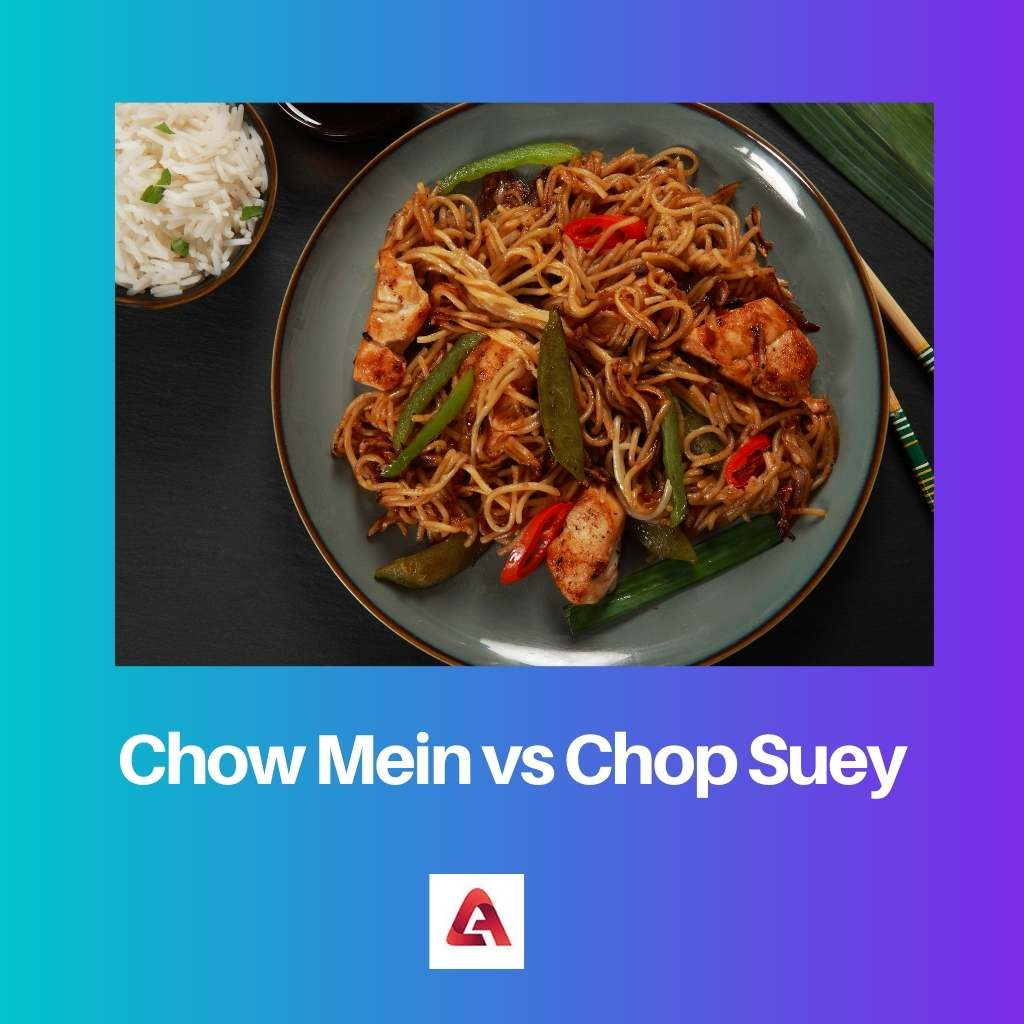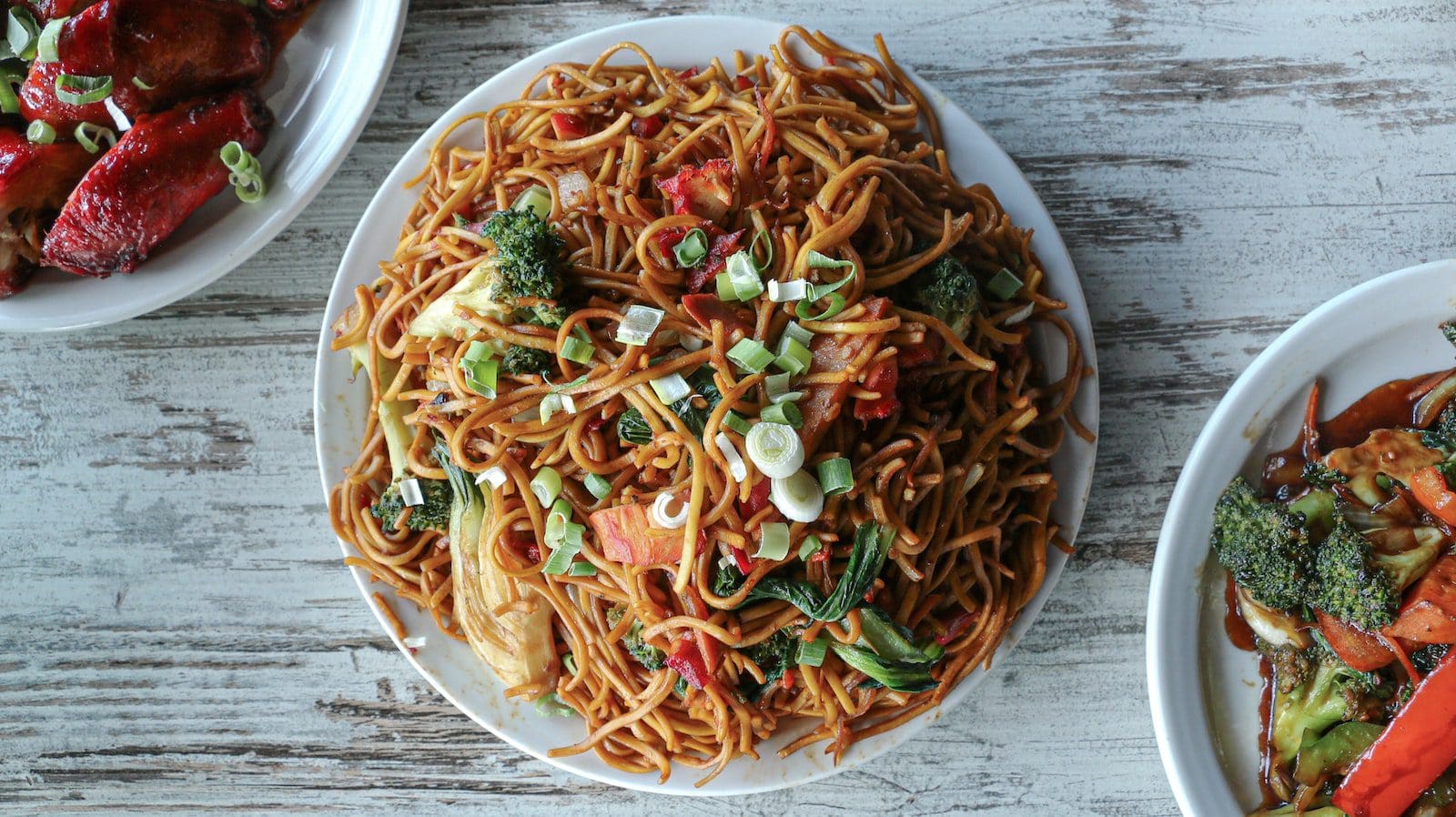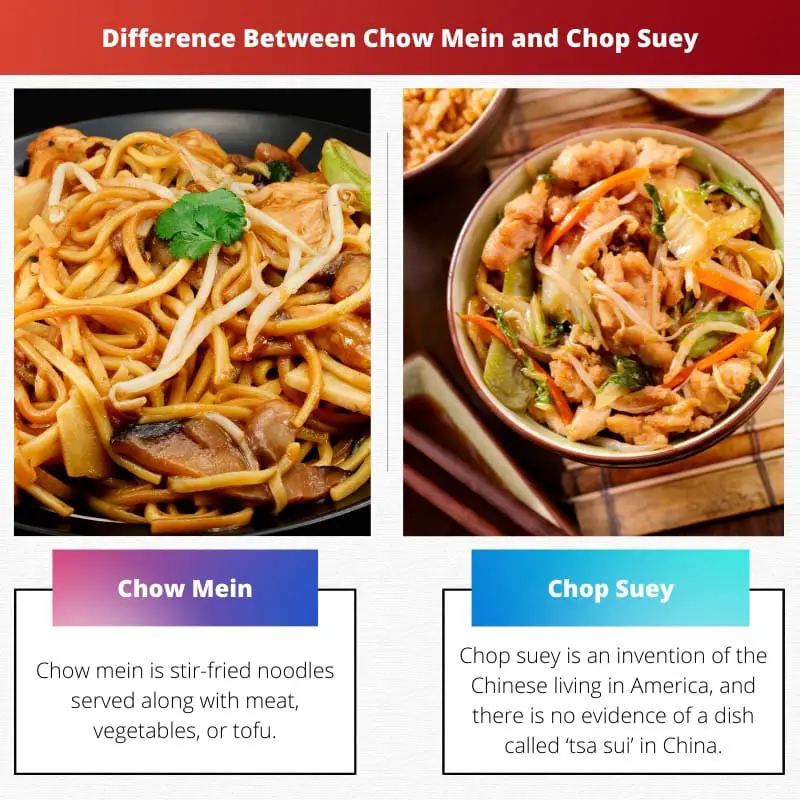Chinese cuisine is the favoured cuisine globally. There is an extensive and diverse range to choose from to enhance the delicacy.
The market has numerous delicious sauces, and there are innumerable recipes to make the favourite delicacy at home.
Both chow mein and chop suey are savoured dishes. They have a blend of noodles, vegetables, and meats.
They have similar looks but have different origins and methods of preparation.
Key Takeaways
- Chow mein is a Chinese dish featuring stir-fried noodles, vegetables, and a choice of protein, such as chicken, beef, or shrimp.
- Chop suey is a dish made from stir-fried vegetables, protein, and a thick sauce, served over rice or noodles.
- Both chow mein and chop suey are popular Chinese-American dishes, but chow mein emphasizes noodles, while chop suey focuses on the vegetable and protein mixture.
Chow Mein vs Chop Suey
Chow mein is a stir-fried dish made with noodles, vegetables, and meat or seafood, pan-fried until crispy and combined with a sauce. Chop suey is a dish with meat, seafood, vegetables, and tofu cooked in a savoury sauce. It is stir-fried or cooked separately and served with rice or noodles.

Chow mein is served with stir-fried noodles gets served along with meat, cabbage, or bok choy in a sauce. The noodles are stir-fried along with the other ingredients to give a moist texture.
The secret is that noodles are never fried but cooked separately and tossed along with other ingredients.
Choy Suey is unique creation personalized by individual chefs. It contains meat, vegetables, egg, and a thick sauce served with either rice or noodles.
Rice is the most preferred combination rather than noodles. As the name rightly suggests, it is a merger of assorted broken pieces.
Comparison Table
| Parameters of Comparison | Chow Mein | Chop Suey |
|---|---|---|
| Origin | It originated from Northern China. | It originated from Southern China. |
| Combination | It is made with noodles. | It is served with noodles. |
| Ingredients | It is made with Soya sauce. | It is accompanied by a thick sauce. |
| Variety | Chow Mein is either steamed or crispy. | It has protein and is served with vegetables. |
| Dish | It is a stir fry with noodles, protein, vegetables, and sauce. | Stir fry with protein, spices, meat, and rice. |
What is Chow Mein?
Chow mein is stir-fried noodles served along with meat, vegetables, or tofu. There are two commonly served chow mein. It is either steamed or made in the crisp Hong Kong style.
Different places serve chow mein unique to the taste buds of the region. The US East Coast prefers the crispy chow mein, and the West Coast relishes on the steamed style.
The dish is among the favourites in many parts of the world. Authentic Chinese preparation has a unique Western twist based on eating habits.
Cooking Method:
- The traditional chow mein needs a variety of ingredients and the crucial being noodles.
- Cooking the noodles at the right temperature and time is essential.
- Coating with sesame oil ensures nonsticky noodles.
- Choosing a protein is vital, and chicken is the most popular option. Pork, shrimp, or tofu are other options.
- Soya Sauce and the secret Five-spice Chinese powder enhance the taste.
- Heating the wok to a high temperature and adding the groundnut oil. Followed by the protein to cook it just right is the trick.
- Add your favourite vegetables and stir fry. The crucial ingredient is noodles, followed by a dash of soya sauce and sesame oil.
The steamed chow mein is soft and loaded with vegetables and blended with soya sauce. The crispy chow mein is slighter dry, crisp, and served with a thick brown gravy. The crispy chow mein doubles up as a delicious sandwich.

What is Chop Suey?
Chop suey is an invention of the Chinese living in America, and there is no evidence of a dish called ‘tsa sui’ in China. Many stories lead to the creation of the delicious chop suey.
One of the stories is about a Chinese chef in a California mining camp. He put together all the available ingredients and named the dish ‘tsa sui’ means miscellaneous broken pieces in Mandarin.
The other story is of a Chinese leader visiting the Palace Hotel in San Francisco and requesting a combination of meat and vegetables in a dish. The obligation of the chef led to the creation of the American Chinese chop suey.
The origin of the dish has many amazing stories. But it consists of meats, vegetables, noodles, or rice cooked in a delicious sauce. Chop suey is a mishmash of different blended ingredients.
Cooking Method:
- The sauce is a crucial part of the recipe. It could comprise vinegar, rice wine, ketchup, soya sauce, cornstarch, and water to make it. There could be other secret ingredients to enhance the taste of the sauce.
- Heat oil in a wok, add onions, and fry till medium brown. Addition of vegetables of your liking and saute lightly. Overcooked vegetables will ruin the taste of the dish.
- Now you could mix the vegetables along with the sauce and serve it over fried noodles or rice.
Chop suey is a stir-fried dish, and the versatility adds to making this dish unique and popular in each region.

Main Differences Between Chow Mein and Chop Suey
- Chow mein consists of noodles, meat, vegetables, and spices. Chop suey is a stir fry with vegetables, meat spices and served along with rice or noodles.
- The origin of chow mein is Northern China. Chop suey originated either from Southern China or Chinese American.
- Chow mein consists of noodles. Chop suey is served either with rice or noodles.
- Soya sauce is a crucial ingredient of chow mein. A thick sauce is the essence of chop suey.
- Chow mein is steamed or fried. Chop suey is a blend of protein, vegetables, and thick sauce.


This article is very insightful, it gives a lot of information about these two dishes and the culture behind them.
Great article about Chinese cuisine, the origin and methods of preparation of dishes are well explained.
I can’t believe a dish like ‘chop suey’ has no origin in China, this is quite interesting.
I completely agree with Gmoore, the variety of dishes makes Chinese cuisine the best.
The content of this post seems a bit too general, you could have explored more specific aspects of the cuisine.
This article is very detailed and comprehensive about Chinese cuisine, it also provides a great explanation about the differences between chow mein and chop suey.
I fully agree, the article is very general, it needs specific examples for a better understanding.